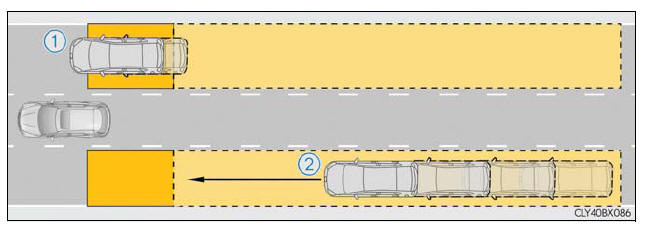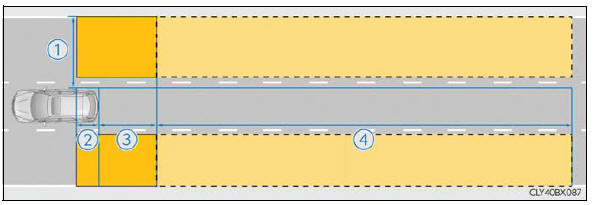Lexus RX (RX 350L, RX450h) 2016-2025 Owners Manual: BSM function
The BSM function uses radar sensors to detect the following vehicles traveling in adjacent lanes and advises the driver of the presence of such vehicles via the indicators on the outside rear view mirrors.

- Vehicles that are traveling in areas that are not visible using the outside rear view mirrors (the blind spots)
- Vehicles that are approaching rapidly from behind in areas that are not visible using the outside rear view mirrors (the blind spots)
BSM function detection areas
The areas that vehicles can be detected in are outlined below.

The range of each detection area is:
- Approximately 1.6 ft. (0.5 m) to 11.5 ft. (3.5 m) from either side of
the vehicle*
*: The area between the side of the vehicle and 1.6 ft. (0.5 m) from the side of the vehicle cannot be detected. - Approximately 3.3 ft. (1 m) forward of the rear bumper
- Approximately 9.8 ft. (3 m) from the rear bumper
- Approximately 9.8 ft. (3 m) to 197 ft. (60 m) from the rear bumper*
*: The greater the difference in speed between your vehicle and the detected vehicle is, the farther away the vehicle will be detected, causing the outside rear view mirror indicator to illuminate or flash.
WARNING
■ Cautions regarding the use of the function The driver is solely responsible for safe driving. Always drive safely, taking care to observe your surroundings.
The BSM function is a supplementary function which alerts the driver that a vehicle is in a blind spot of the outside rear view mirrors or is approaching rapidly from behind into a blind spot. Do not overly rely on the BSM function. As the function cannot judge if it is safe to change lanes, over reliance could lead to an accident resulting in death or serious injury.
As the system may not function correctly under certain conditions, the driver's own visual confirmation of safety is necessary.
■ The BSM function is operational when The BSM function is operational when all of the following conditions are met:
- The BSM function is on.
- The shift lever is in a position other than R.
- The vehicle speed is greater than approximately 10 mph (16 km/h).
■ The BSM function will detect a vehicle when The BSM function will detect a vehicle present in the detection area in the following situations:
- A vehicle in an adjacent lane overtakes your vehicle.
- Another vehicle enters the detection area when it changes lanes.
■ Conditions under which the BSM function will not detect a vehicle The BSM function is not designed to detect the following types of vehicles and/or objects:
- Small motorcycles, bicycles, pedestrians, etc.*
- Vehicles traveling in the opposite direction
- Guardrails, walls, signs, parked vehicles and similar stationary objects*
- Following vehicles that are in the same lane*
- Vehicles traveling 2 lanes away from your vehicle*
*: Depending on the conditions, detection of a vehicle and/or object may occur.
■ Conditions under which the BSM function may not function correctly
- The BSM function may not detect vehicles correctly in the following
situations:
- When the sensor is misaligned due to a strong impact to the sensor or its surrounding area
- When mud, snow, ice, a sticker, etc. is covering the sensor or surrounding area on the rear bumper
- When driving on a road surface that is wet with standing water during bad weather, such as heavy rain, snow, or fog
- When multiple vehicles are approaching with only a small gap between each vehicle
- When the distance between your vehicle and a following vehicle is short
- When there is a significant difference in speed between your vehicle and the vehicle that enters the detection area
- When the difference in speed between your vehicle and another vehicle is changing
- When a vehicle enters a detection area traveling at about the same speed as your vehicle
- As your vehicle starts from a stop, a vehicle remains in the detection area
- When driving up and down consecutive steep inclines, such as hills, dips on the road, etc.
- When driving on roads with sharp bends, consecutive curves, or uneven surfaces
- When vehicle lanes are wide, or when driving on the edge of a lane, and the vehicle in an adjacent lane is far away from your vehicle
- When towing a trailer (vehicles with towing package)
- When items such as a bicycle carrier are installed on the rear of the vehicle
- When there is a significant difference in height between your vehicle and the vehicle that enters the detection area
- Immediately after the BSM function is turned on
- Instances of the BSM function unnecessarily detecting a vehicle and/or
object may
increase in the following situations:
- When the sensor is misaligned due to a strong impact to the sensor or its surrounding area
- When the distance between your vehicle and a guardrail, wall, etc. that enters the detection area is short
- When driving up and down consecutive steep inclines, such as hills, dips on the road, etc.
- When vehicle lanes are narrow, or when driving on the edge of a lane, and a vehicle traveling in a lane other than the adjacent lanes enters the detection area
- When driving on roads with sharp bends, consecutive curves, or uneven surfaces
- When the tires are slipping or spinning
- When the distance between your vehicle and a following vehicle is short
- When a bicycle carrier or other accessory is installed to the rear of the vehicle
- When towing a trailer (vehicles with towing package)
 BSM (Blind Spot Monitor)
BSM (Blind Spot Monitor)
Summary of the Blind Spot Monitor
The Blind Spot Monitor is a system that has 2 functions:
The BSM (Blind Spot Monitor) function
Assists the driver in making a decision when changing lanes
Th ...
 RCTA function
RCTA function
The RCTA function uses radar sensors to detect vehicles approaching from the
right or left at the rear of the vehicle and alerts the driver of the presence
of such
vehicles by flashing the outside ...
Other materials:
Lexus RX (RX 350L, RX450h) 2016-2025 Repair Manual > Power Seat Switch(w/ Seat Position Memory System): Installation
INSTALLATION CAUTION / NOTICE / HINT CAUTION: Wear protective gloves. Sharp areas on the parts may injure your hands. PROCEDURE 1. INSTALL POSITION CONTROL ECU AND SWITCH ASSEMBLY LH (a) Install the position control ECU and switch assembly LH to the front seat cushion shield LH with the 3 screws. ...
Lexus RX (RX 350L, RX450h) 2016-2025 Repair Manual > Parking Assist Ecu: Installation
INSTALLATION PROCEDURE 1. INSTALL PARKING ASSIST ECU (a) Install the parking assist ECU with the bolt and nut. (b) Connect each connector. 2. INSTALL GLOVE COMPARTMENT DOOR ASSEMBLY Click here 3. INSTALL NO. 2 INSTRUMENT PANEL UNDER COVER SUB-ASSEMBLY Click here 4. INSTALL COWL SIDE TRIM BOARD R ...
Lexus RX (RX 350L, RX450h) 2016-{YEAR} Owners Manual
- For your information
- Pictorial index
- For safety and security
- Instrument cluster
- Operation of each component
- Driving
- Lexus Display Audio system
- Interior features
- Maintenance and care
- When trouble arises
- Vehicle specifications
- For owners
Lexus RX (RX 350L, RX450h) 2016-{YEAR} Repair Manual
0.0121
